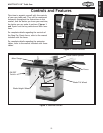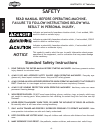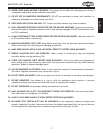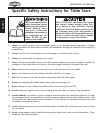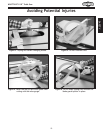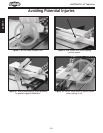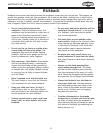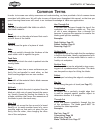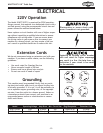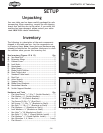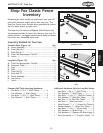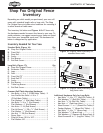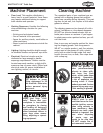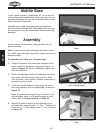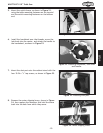
-12-
W1677/W1711 10" Table Saw
SAFETY
Common Terms
In order to increase user safety awareness and understanding, we have provided a list of common terms
associated with table saws. We will refer to many of these terms throughout this manual, so the time you
spend learning these terms will result in an increased knowledge of table saw applications.
Arbor
The shaft underneath the table on which
the blade mounts.
Bevel
An angled cut on the edge of a board that reach
-
es both faces of the board.
Crosscut
To cut across the grain of a piece of stock.
Dado
A slot cut partially through the thickness of the
stock either with or against the grain.
Feed Rate
The speed at which the stock is pushed into the
moving blade.
Flush
A condition when two or more surfaces are per
-
fectly flat and parallel to each other, so that
their touching edges have an even surface.
Kerf
The width of the material that a blade removes
from the workpiece.
Kickback
The event in which the stock is ejected from the
blade at a high rate of speed toward the opera
-
tor. Usually caused by binding the blade or by
a blade condition that forces the momentum of
the blade to push the stock away.
Miter Cut
An angled cut across the face or end of a board.
Usually cut to match another board of a corre
-
sponding angle so that each cut piece fits per
-
fectly into the other, thus changing the direc
-
tion of the workpiece.
Non Through-Cut
A cut that does not pass through the top of the
workpiece—i.e. a dado or rabbet cut. This type
of cut is more dangerous than a through cut
because it requires the operator to remove the
blade guard/splitter assembly.
Examples:
Dado Cutting: Page 29
Rabbet Cutting: Page 31
Resawing: Page 33
Outfeed Side
The opposite side of the table that the workpiece
is fed into the blade. Usually supplemented with
an aftermarket or shop-made table to catch a
freshly cut workpiece.
Positive Stop
A bolt or pin that can be adjusted to stop a mov
-
ing part at a predetermined location. This table
saw has positive stops for tilting the blade.
Rabbet
An L-shaped cut along the edge of a workpiece.
Rip Cut
To cut along the grain of stock (see Page 2
7).
Straightedge
An object with a perfectly straight edge that
is used to compare against another object to
determine whether it is straight.
Through-Cut
A cut that passes completely through the top
of the workpiece. The blade guard MUST be
installed for safest operation.
Examples:
Rip Cuts: Page 2
7
Crosscutting: Page 28
Miter Cuts: Page 28
Blade Tilt/Bevel Cuts: Page 27




